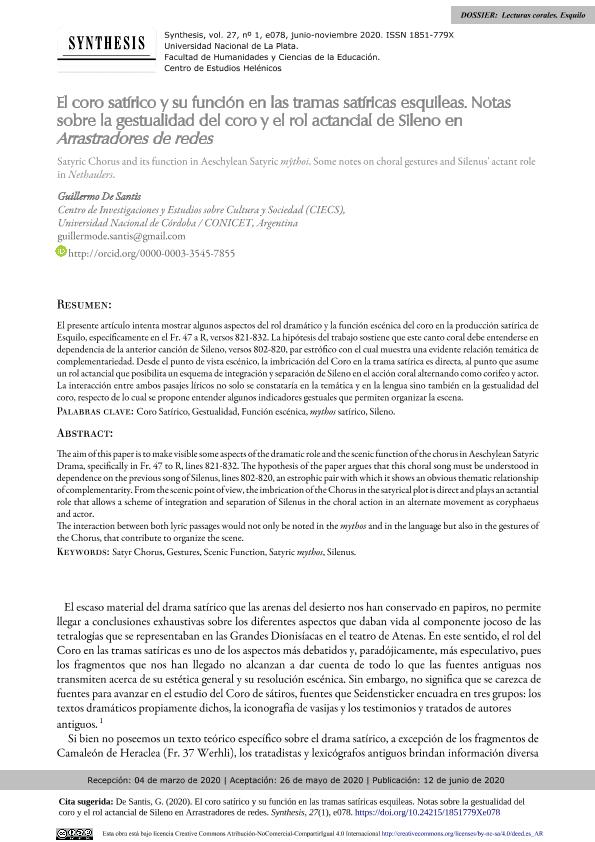Mostrar el registro sencillo del ítem
dc.contributor.author
de Santis, Guillermo

dc.date.available
2021-09-16T19:46:21Z
dc.date.issued
2020-09
dc.identifier.citation
de Santis, Guillermo; El coro satírico y su función en las tramas satíricas esquileas: Notas sobre la gestualidad del coro y el rol actancial de Sileno en Arrastradores de redes; Universidad Nacional de La Plata. Facultad de Humanidades y Ciencias de la Educación; Synthesis (La Plata); 27; 1; 9-2020; 1-13; e078
dc.identifier.issn
1851-779X
dc.identifier.uri
http://hdl.handle.net/11336/140594
dc.description.abstract
El presente artículo intenta mostrar algunos aspectos del rol dramático y la función escénica del coro en la producción satírica de Esquilo, específicamente en el Fr. 47 a R, versos 821-832. La hipótesis del trabajo sostiene que este canto coral debe entenderse en dependencia de la anterior canción de Sileno, versos 802-820, par estrófico con el cual muestra una evidente relación temática de complementariedad. Desde el punto de vista escénico, la imbricación del Coro en la trama satírica es directa, al punto que asume un rol actancial que posibilita un esquema de integración y separación de Sileno en el acción coral alternando como corifeo y actor. La interacción entre ambos pasajes líricos no solo se constataría en la temática y en la lengua sino también en la gestualidad del coro, respecto de lo cual se propone entender algunos indicadores gestuales que permiten organizar la escena.
dc.description.abstract
The aim of this paper is to make visible some aspects of the dramatic role and the scenic function of the chorus in Aeschylean Satyric Drama, specifically in Fr. 47 to R, lines 821-832. The hypothesis of the paper argues that this choral song must be understood in dependence on the previous song of Silenus, lines 802-820, an estrophic pair with which it shows an obvious thematic relationship of complementarity. From the scenic point of view, the imbrication of the Chorus in the satyrical plot is direct and plays an actantial role that allows a scheme of integration and separation of Silenus in the choral action in an alternate movement as coryphaeus and actor. The interaction between both lyric passages would not only be noted in the mythos and in the language but also in the gestures of the Chorus, that contribute to organize the scene.
dc.format
application/pdf
dc.language.iso
spa
dc.publisher
Universidad Nacional de La Plata. Facultad de Humanidades y Ciencias de la Educación

dc.rights
info:eu-repo/semantics/openAccess
dc.rights.uri
https://creativecommons.org/licenses/by-nc-sa/2.5/ar/
dc.subject
CORO SATÍRICO
dc.subject
GESTUALIDAD
dc.subject
FUNCIÓN ESCÉNICA
dc.subject
MYTHOS SATÍRICO
dc.subject.classification
Literaturas Específicas

dc.subject.classification
Lengua y Literatura

dc.subject.classification
HUMANIDADES

dc.title
El coro satírico y su función en las tramas satíricas esquileas: Notas sobre la gestualidad del coro y el rol actancial de Sileno en Arrastradores de redes
dc.title
Satyric Chorus and its function in Aeschylean Satyric mŷthoi. Some notes on choral gestures and Silenus' actant role in Nethaulers
dc.type
info:eu-repo/semantics/article
dc.type
info:ar-repo/semantics/artículo
dc.type
info:eu-repo/semantics/publishedVersion
dc.date.updated
2021-08-20T19:36:53Z
dc.identifier.eissn
0328-1205
dc.journal.volume
27
dc.journal.number
1
dc.journal.pagination
1-13; e078
dc.journal.pais
Argentina

dc.journal.ciudad
La Plata
dc.description.fil
Fil: de Santis, Guillermo. Consejo Nacional de Investigaciones Científicas y Técnicas. Centro Científico Tecnológico Conicet - Córdoba. Centro de Investigaciones y Estudios sobre Cultura y Sociedad. Universidad Nacional de Córdoba. Centro de Investigaciones y Estudios sobre Cultura y Sociedad; Argentina
dc.journal.title
Synthesis (La Plata)

dc.relation.alternativeid
info:eu-repo/semantics/altIdentifier/url/https://www.synthesis.fahce.unlp.edu.ar/article/view/SYNe078
dc.relation.alternativeid
info:eu-repo/semantics/altIdentifier/url/https://www.redalyc.org/journal/846/84664017008/html/
Archivos asociados
